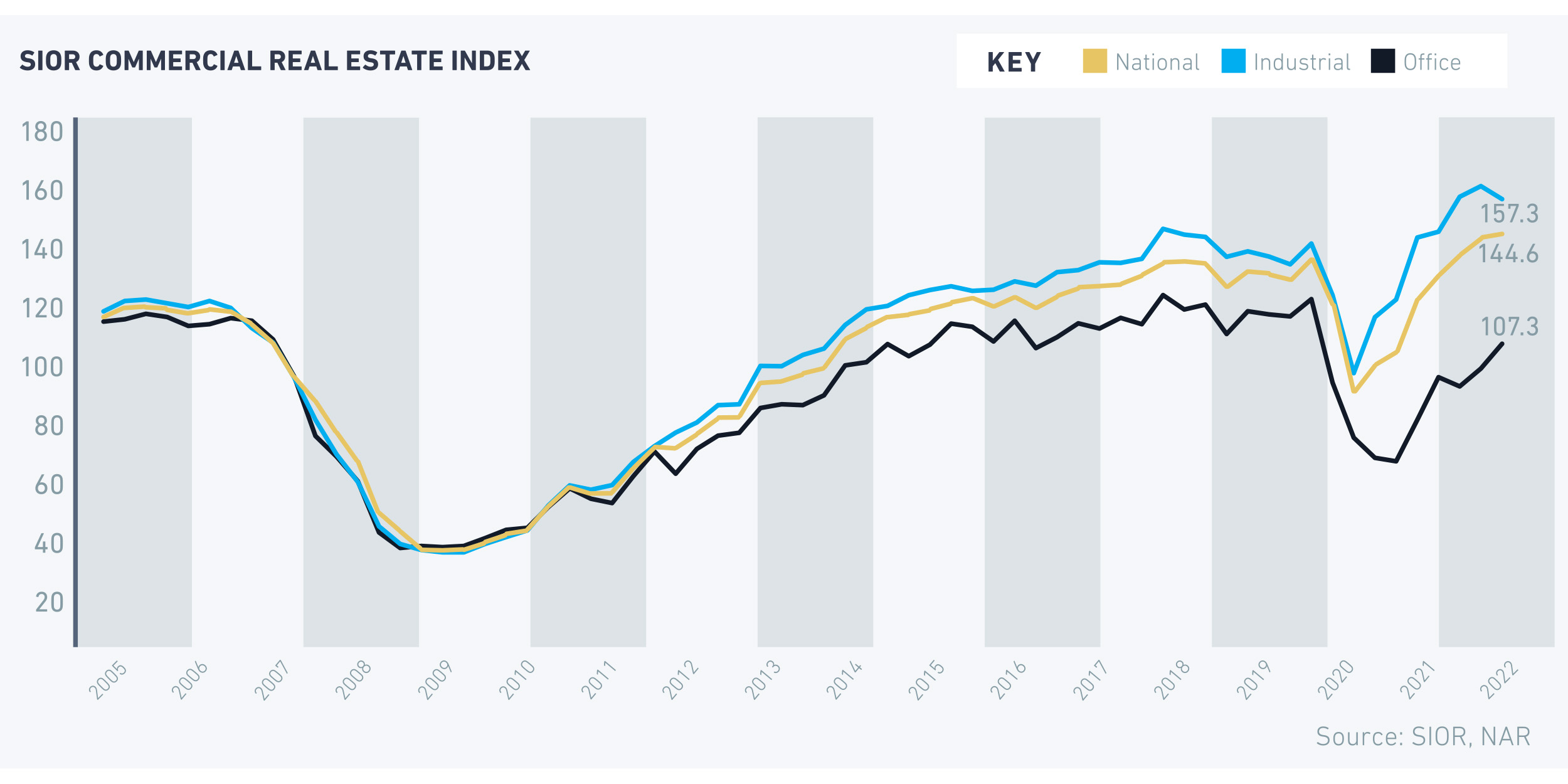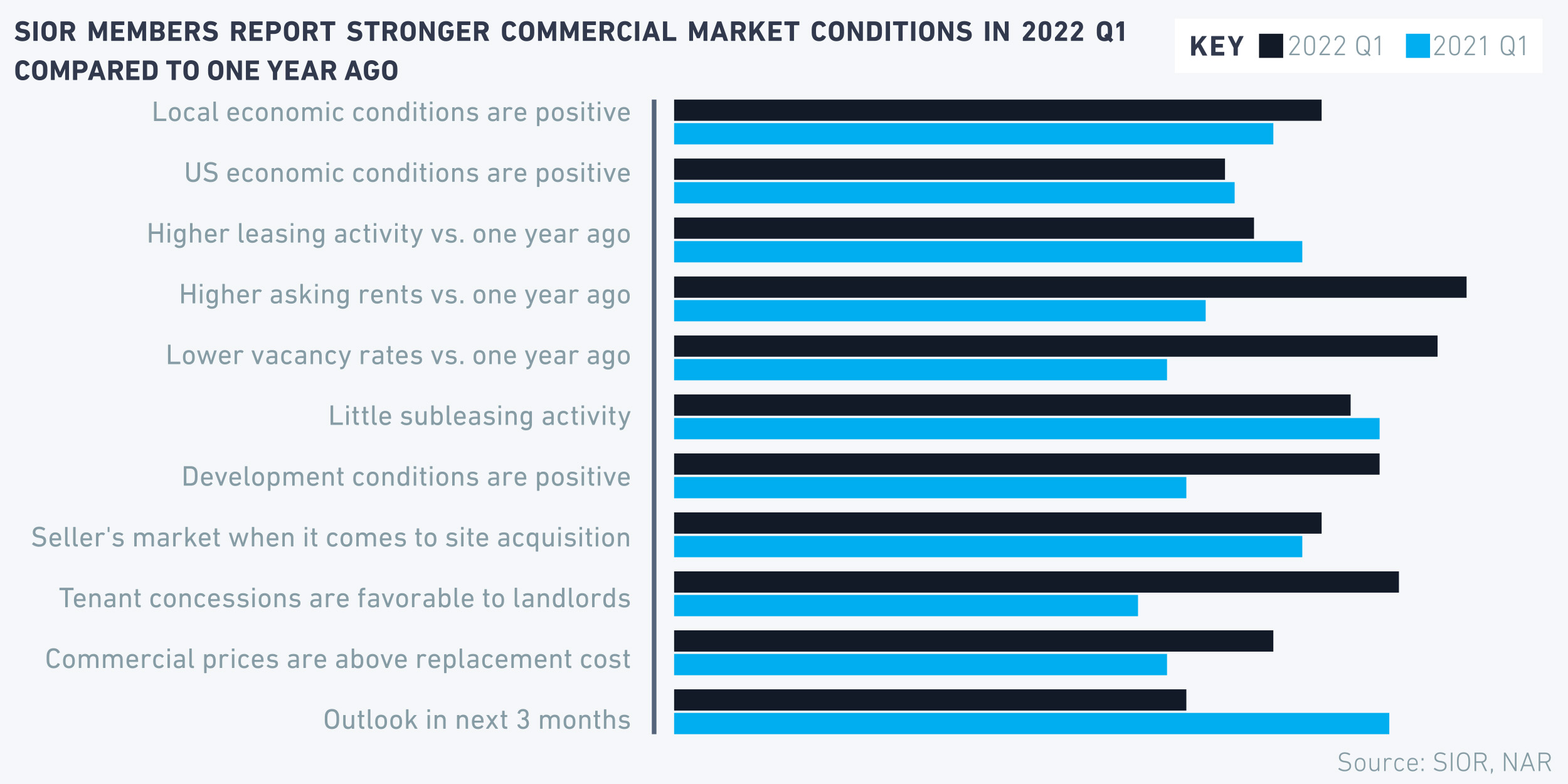This writeup reflects data from U.S.-only respondents. For a report on global conditions, see the SIOR Sentiment Survey.
Industrial and office market conditions continued to strengthen in the first quarter of 2022 compared to to one year ago, according to SIOR members who participated in the 2022 Q1 market conditions survey. The Commercial Real Estate Index rose to 144.6, up from the prior quarter (143.3) and from one year ago (122.2). An index of 100 indicates “strong” market conditions based on ten indicators pertaining to the national and local economy, leasing, rents, development activity, and commercial real estate prices.

OFFICE AND INDUSTRIAL MARKET TRENDSThis time, it’s the office market that made a strong recovery. For the first time since the pandemic (2020 Q1), the office index finally hit over 100, at 107.3. Occupancy has been rising, even if modestly, with 21.4 million square feet (MSF) of office space absorbed since the second half of 2021 through the first quarter of 2022. However, there is still nearly 115 MSF of office space that has become vacant since the pandemic, according to CoStar® data. The bulk of the occupancy loss is in the primary metro areas of New York (-29 MSF), Los Angeles (-11.5 MSF), San Francisco (-9.4 MSF), Chicago (-9.1 MSF), Washington, D.C. (-8.3 MSF), and Philadelphia (-5.9 MSF). However, secondary markets have seen a rise in office occupancy since the second quarter of 2020 led by Austin, Texas (1.6 MSF), Boise, Idaho (1.5 MSF), Palm Beach, Fla. (1.4 MSF), Provo, Utah (1.4 MSF), Durham (1.2 MSF), and Las Vegas (1 MSF).
Demand for office space has been rising with workers continuing a return to the office. As of April, only 13% of employed workers 16 years old and over in professional/business and office support industries teleworked at any time during April, down from 54% in May 2020, according to the Bureau of Labor Statistics’ monthly supplemental survey.1 In number of employees, 10.8 million worked from home at any time in April, about a quarter of the 41.5 million who worked from home in May 2020. Strong job growth is also arguably increasing the demand for office space. As of April, the economy has generated nearly 21 million jobs, with just 1.2 million jobs to recover of the 22.5 million jobs that were lost in March and April 2020 at the height of the economic lockdown. In the professional and business services and financial activities (includes real estate, rental, and leasing), industries, there are 857,000 more jobs as of April 2022 compared to February 2020. Still, because more workers are teleworking, CBRE estimates a 9% decrease in the demand for office space, even accounting for peak usage.2
The SIOR Industrial Index also registered at over 100, at 157.3, up from one year ago (143.7) although slightly lower than the level in the prior quarter (161.5). In the first quarter, 97 MSF of industrial space was absorbed. Absorption has slowed compared to about 160 MSF in the third quarter of 2021, but the demand for industrial space is still solidly positive. Rents are rising at 11% year-over-year as the vacancy rate has fallen to just 4.1%.
Demand for industrial space is coming. According to US Census’ Bureau’s retail sales data, the dollar volume of sales of non-store retailers hit $1 trillion in June 2020, and the share of non-store retailers to total retail sales rose to a high of 16.9% in February 2021. According to CoStar® market data, about 700 MSF of industrial real estate space has been absorbed since the second quarter of 2020 through the fourth quarter of 2021. The industrial vacancy rate has fallen to 4.2% as of the last quarter of 2021 while rents were up 8.7% year-over-year.
Retailers and wholesalers alike are increasing demand for industrial space for warehousing, distribution, and as fulfillment centers. In 2021, electronic and mail-order shopping totaled $1 trillion, or 16% of retail sales, a sustained increase from just 13% prior to the pandemic.
Supply chain issues are easing somewhat. Retail inventories in the first quarter of 2022 are up 11% year-over-year while wholesale inventories increased 22% from one year ago. However, inventory remains tight, with inventory to sales ratios (1.1x) still below pre-pandemic levels (1.4x).

2022 OUTLOOK: SUSTAINED CRE RECOVERY AMID RISING INTEREST RATESBroadly, respondents reported stronger market conditions in the first quarter of 2022 compared to one year ago. Eighty two percent of respondents reported higher asking rents compared to one year ago, and 79% reported lower vacancy rates compared to one year ago. Seventy-five percent reported that tenant concessions are now favorable to landlords. Seventy-three percent of respondents reported that development conditions are positive.
However, respondents appear to be concerned about the impact of rising interest rates on the commercial real estate market. Sixty-seven percent of respondents reported local market conditions are positive, while 57% of respondents reported that U.S. economic conditions are positive. Rising interest rates are likely of concern to respondents. Only 53% of respondents expect a better economic outlook in the next three months, compared to 74% of respondents at this time last year.
For 2022, our assessment is that the jobs recovery remains intact, although higher interest rates slow economic growth to about 2% in 2022, from 4.7% in 2021.
Rising mortgage rates will prop up demand for apartments, which will tend to lower vacancy rates in 2022-2023 and sustained double-digit rent and price growth which will further push down cap rates to the lower 5%.
Slower economic growth is expected to slightly reduce the demand for industrial space. However, as businesses increase the level of inventory to minimize supply chain disruptions, this will increase demand for industrial space. Moreover, the current construction of industrial space that amounts to 3% of inventory will ease vacancy rates, lower rent and price growth to below 10%, and push cap rates upwards to the lower 6%.
Rising inflation will hit the retail sector the most, as consumers cut back on non-essential spending. However, neighborhood centers that are anchored around grocery stores are likely to do well compared to malls. As vacancy rates rose, rent and price growth will slow which will tend to push cap rate upwards. Given the low level of construction activity in this property market, vacancy rates are likely to stay at around 5%.
With workers continuing to head back to the office, the higher demand for office space is expected to moderate the decline in demand due to slower new business formation. This will slightly reduce vacancy rates although the vacancy rate will likely remain above 10%. Rent and price growth will remain modest but the stronger sales price appreciation will push cap rate towards 6%.
1. The survey asks if the person teleworked at home at any time because of the coronavirus pandemic. The share can be underestimated if workers are teleworking because this has become their working arrangement, and not “because of the pandemic”.
2. Matt Vance, presentation at NAR Legislative Meetings, May 4, 2022